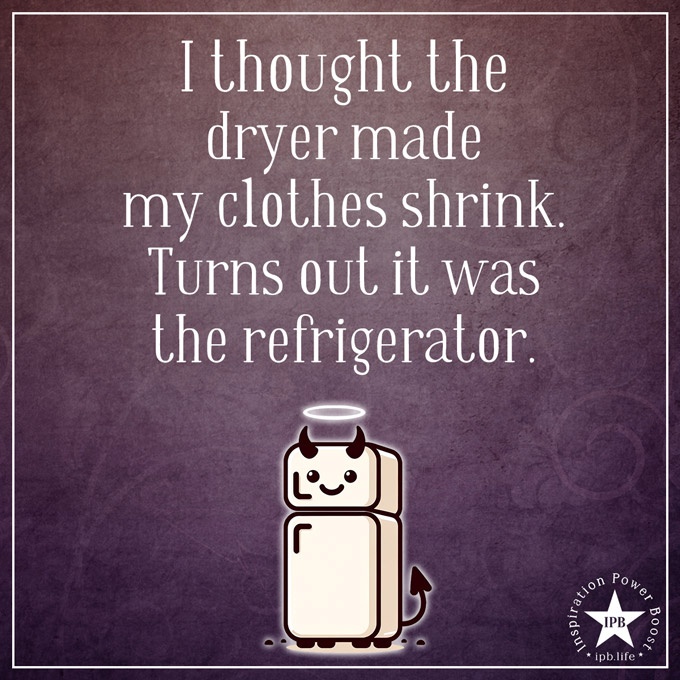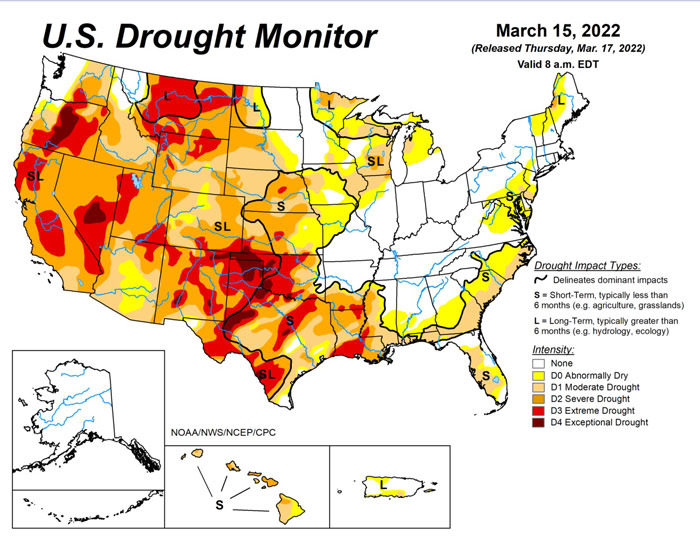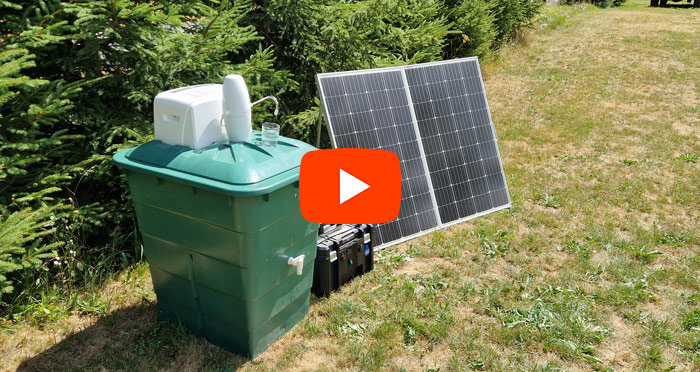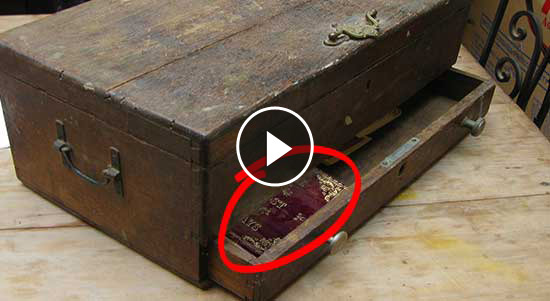
I Thought The Dryer Made My Clothes Shrink Graphic © InspirationPowerBoost.com
“I thought the dryer made my clothes shrink. Turns out it was the refrigerator.”
We’ve found the culprit.
Sitting there innocently in the kitchen, humming away contentedly. If you squint you can see the halo but it’s the fridge that’s the devil in disguise…
The History Of The Refrigerator
So much for the ‘dark side’ of the fridge. It’s fascinating to learn about how different life was without this “modern essential”.
The concept of refrigeration dates back to ancient times when people used snow and ice to preserve food. In the 4th century BC, Aristotle discussed the cooling effects of evaporation. Ancient Egyptians and Indians also used evaporative cooling techniques. In the 18th century, the discovery of endothermic reactions, where certain chemical reactions absorb heat, laid foundational principles for artificial refrigeration.
Iceboxes and the Emergence of Artificial Refrigeration: Before the advent of modern refrigeration, iceboxes were common in households in the 19th century. These insulated boxes used large blocks of ice to keep food cold.
But where did the ice come from?
Ice was delivered door to door in the 19th century! This fascinating, forgotten trade was a critical part of daily life before the widespread availability of mechanical refrigeration.
In the early to mid-19th century, the ice trade became a significant industry, particularly in the United States. Large blocks of natural ice were harvested from lakes and ponds during the winter, stored in ice houses insulated with sawdust or straw, and then distributed in warmer months.
The process of cutting the ice was labor-intensive and required a combination of skill and specialized tools.
Preparation of the Ice Surface: First, any snow on the ice surface was cleared. This was important because a layer of snow would insulate the ice from the cold air, slowing its thickening, and could also lead to a poor quality harvest with impurities.
Scoring the Ice: Workers scored the ice to create a grid pattern. This was initially done with a horse-drawn marker, a tool that etched lines in the ice. These lines served as guides for cutting the ice into uniform blocks.
Sawing the Ice: The actual cutting of ice was done with large, toothed saws. Initially, this was a manual process, with workers using hand saws. Later on, horse-drawn or steam-powered saws were introduced to increase efficiency. The saws cut through the ice following the scored lines, but not all the way through, leaving a small section at the bottom intact.
Breaking and Lifting the Ice Blocks: After the ice was cut, workers used bars and chisels to break the blocks free from the main sheet. The blocks, often weighing several hundred pounds, were then pried out of the water with ice forks or tongs.
Transportation to Ice Houses: Once cut, the blocks of ice were transported to nearby ice houses for storage. This was often done using a system of conveyors, slides, or ramps, sometimes aided by horse-drawn sleds or wagons. The ice houses were insulated structures, often built partially underground or with thick walls filled with insulating materials like sawdust or straw to keep the ice from melting.
Storage and Preservation: Inside the ice houses, the ice blocks were packed tightly and covered with insulating materials like sawdust. This method of storage could keep the ice frozen for many months, often until the next winter season.
The advent of this commercial ice harvesting and storage technology in the 19th century revolutionized food storage and preservation, and it played a significant role in the development of the cold food chain. The efficiency and scale of the ice trade grew over the century, peaking in the late 1800s before the advent of mechanical refrigeration began to supplant the natural ice industry in the early 20th century.
Frederick Tudor, known as the “Ice King,” was a pioneering figure in this industry, beginning in the early 1800s. He even started shipping ice from New England to distant locations, including the Caribbean and Europe.
Door-to-door ice delivery was common in urban areas. Households used iceboxes, which were essentially insulated boxes where a large block of ice was placed to keep the food inside cool and slow down spoilage. The ice delivery men, often referred to as “icemen,” would make regular rounds in neighborhoods, carrying blocks of ice with large tongs and delivering them directly to homes. Families would typically display a card in their window indicating how much ice they needed, which the iceman would then provide.
In 1834, Jacob Perkins, an American inventor, built the first working vapor-compression refrigeration system, though it was not immediately practical for widespread use. This trade remained prevalent until the advent and proliferation of electric refrigerators in the 20th century, which gradually made the practice of door-to-door ice delivery obsolete. The transition to mechanical refrigeration marked a significant shift in food storage and preservation methods and was the key factor in phasing out the once-thriving ice trade.
Commercial and Domestic Refrigeration: Commercial refrigeration took a significant leap forward in the late 19th and early 20th centuries, with industries now using mechanical refrigeration systems for food storage and transportation. The first practical and widely used refrigeration system was developed by Carl von Linde, a German engineer, in the 1870s.
However, it wasn’t until the 1910s and 1920s that refrigerators began to become a common household item. These early models used toxic gases like ammonia, methyl chloride, or sulfur dioxide as refrigerants, which occasionally led to fatal accidents.
CFCs And Refrigerators
Safe and Modern Refrigeration: The turning point for safe household refrigerators came with the invention of Freon (chlorofluorocarbons) as a refrigerant in the 1930s by Thomas Midgley, Jr. Freon was non-toxic, non-flammable, and effective, which led to widespread refrigerator use in homes. However, by the late 20th century, it was discovered that CFCs were harmful to the ozone layer, leading to the development of more environmentally friendly refrigerants.
CFCs, once widely used in refrigerators as refrigerants, are no longer used in new refrigeration and air conditioning systems. This change is primarily due to the significant environmental impact of CFCs, particularly their role in depleting the Earth’s ozone layer.
The realization of the harmful effects of CFCs led to international action, most notably the Montreal Protocol, an international treaty agreed upon in 1987. The Montreal Protocol aimed to phase out the production and use of ozone-depleting substances, including CFCs. This treaty has been remarkably successful and is considered one of the most effective international environmental agreements. As a result, the production and use of CFCs have been phased out in most parts of the world.
Modern refrigerators use alternative refrigerants that are less harmful to the ozone layer. Hydrochlorofluorocarbons (HCFCs) were initially used as a transitional substitute for CFCs, but they also contribute to ozone depletion, albeit to a lesser extent. Consequently, their use is also being phased out under the terms of the Montreal Protocol.
The most common refrigerants in use today are hydrofluorocarbons (HFCs) and, increasingly, hydrocarbons (HCs) like isobutane and propane. These substances have a much lower potential for ozone depletion. However, HFCs do contribute to global warming, so there is ongoing research and development into more environmentally friendly alternatives, such as natural refrigerants and HFOs (hydrofluoroolefins), which have a lower global warming potential.
Over the years, refrigerators have evolved significantly in terms of efficiency, size, and features. The introduction of automatic defrosting and ice making in the 1950s and 1960s were major milestones. Today’s refrigerators offer a range of advanced electronic features like energy efficiency, digital temperature controls, smart technology integration, and varied designs to suit modern kitchens.
😳 What Tinnitus Does To Your Brain Cells (And How To Stop It)
After 47 years of studies and countless brain scans done on more than 2,400 tinnitus patients, scientists at the MIT Institute found that in a shocking 96% of cases, tinnitus was actually shrinking their brain cells.
As it turns out, tinnitus and brain health are strongly linked.
Even more interesting: The reason why top army officials are not deaf after decades of hearing machine guns, bombs going off and helicopter noises…
Is because they are using something called "the wire method", a simple protocol inspired by a classified surgery on deaf people from the 1950s...
This Crazy Off Grid Device Literally Makes Drinkable Water From Fresh Air:
According to NASA, the U.S. is expecting a 100-YEAR LONG MEGADROUGHT.
It's already begun. Ask the farmers in California. They know.
Every survivalist knows that water is of critical importance. You NEED an independent water source that you can count on!
As an interesting "survival rehearsal" - imagine that you turned the tap on right now and nothing came out. How long would you last?
But what if there was another water source literally hidden in plain sight? That's right, I'm talking about the atmosphere!
The amazing thing about getting water from the natural moisture in the air... is that it is ALWAYS available.
This gives you real water security!
Learn more about how to tap into "Nature's secret water reservoir" and stay hydrated when TSHTF!
Watch the video:
Most People Don't Have The Guts To Try This:
An amazing discovery in an abandoned house in Austin, Texas: A lost book of amazing survival knowledge, believed to have been long vanished to history, has been found in a dusty drawer in the house which belonged to a guy named Claude Davis.
Remember... back in those days, there was no electricity... no refrigerators... no law enforcement... and certainly no grocery store or supermarkets... Some of these exceptional skills are hundreds of years of old and they were learned the hard way by the early pioneers.
>> Click here to find out about them now
We've lost to history so much survival knowledge that we've become clueless compared to what our great grandfathers did or built on a daily basis to sustain their families.
Neighbors said that for the last couple of years Claude has tried to unearth and learn the forgotten ways of our great-grandparents and claimed to have found a secret of gargantuan proportions. A secret that he is about to reveal together with 3 old teachings that will change everything you think you know about preparedness:






